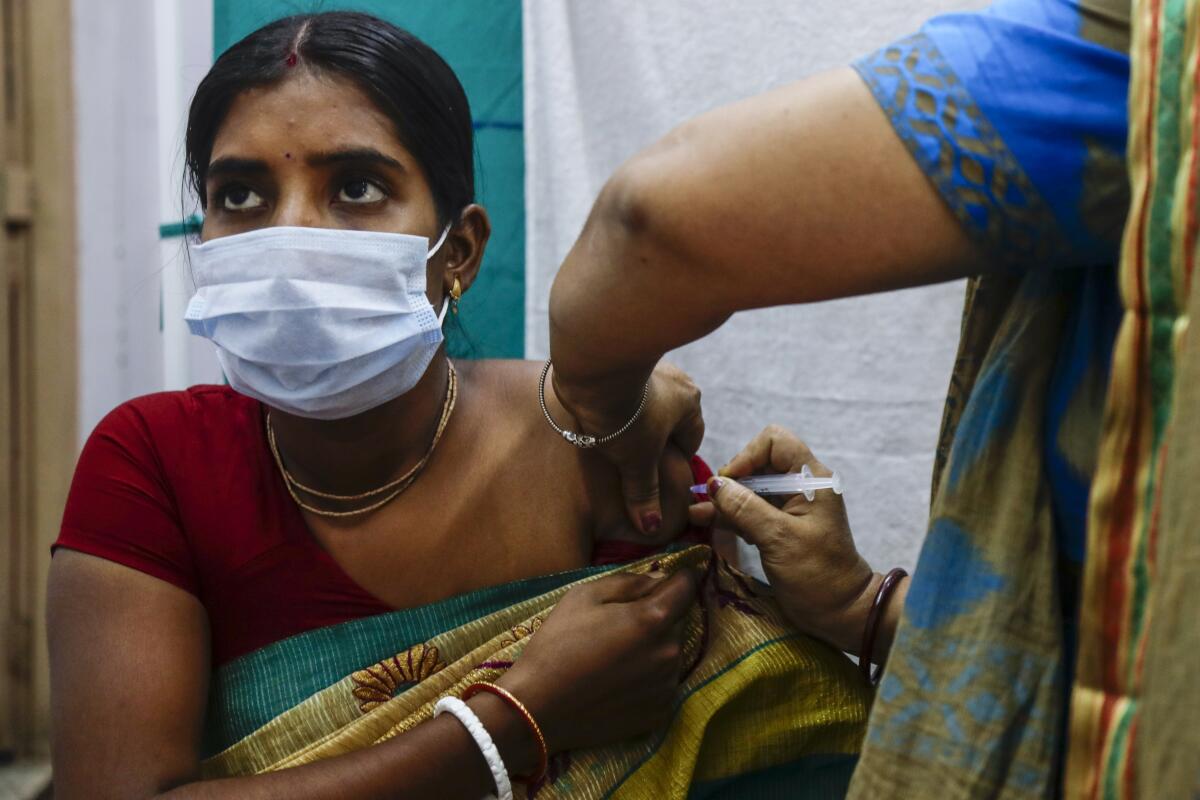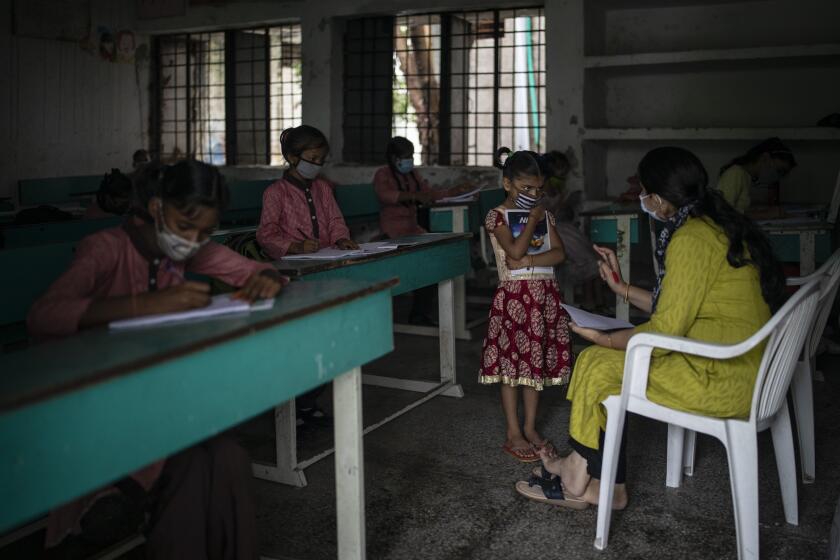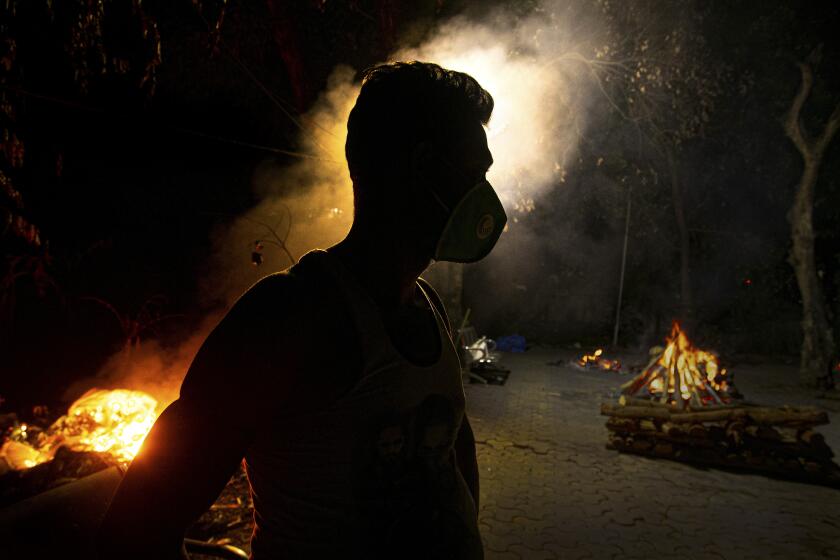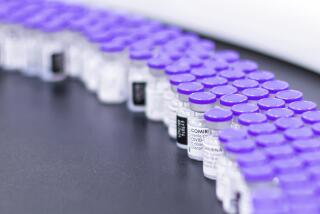India hits 1-billion COVID vaccination landmark but worries about follow-up shots

- Share via
NEW DELHI — India celebrated giving its billionth COVID-19 vaccine dose Thursday, a hopeful milestone for a country where the Delta variant fueled a devastating coronavirus surge earlier this year and missteps initially held back its inoculation campaign.
About half of India’s nearly 1.4 billion people have received at least one dose, with around 20% of the population fully immunized, according to Our World in Data. Many of those shots have come in just the past couple of months, after the campaign languished in the first half of the year amid vaccine shortages and problems with the system for rolling them out. India is using vaccines that require two doses.
The success of the campaign has been credited with driving down coronavirus cases since the devastating months at the start of the year when India was recording hundreds of thousands of infections a day, hospitals buckled under the pressure, and crematoriums and graveyards became overwhelmed. But experts warn that India must speed up the delivery of second shots in order to ensure that another outbreak doesn’t flare up.
The country widened the gap between first and second shots from 12 to 16 weeks in order to administer more first doses at a time when supply was limited and infections were surging. But it created a lag in getting people fully immunized.
Ramping up the administering of second doses is “an important priority,” V.K. Paul, the head of the country’s COVID-19 taskforce, said last week.
“We would like to see this number go up. Complete coverage is absolutely critical,” Paul said.
Education lifts many out of poverty in India, but COVID has closed schools. Now India is bracing for a surge in child labor and underage marriages.
For now, India appears to have enough doses to do that — but its supplies will be watched closely since it is a major supplier of the shots globally. A decision to halt exports in April as cases surged at home had a devastating impact on poorer countries that particularly rely on doses from India. Exports resumed earlier this month.
The government is now optimistic that the country’s rising vaccine supply will be enough to cover its international and domestic commitments. Both of the two main suppliers have increased production, with the Serum Institute of India now producing around 220 million doses a month and Bharat Biotech about 30 million, Paul said.
Still, experts say the vaccine situation will need constant review.
“There can be no written-in-stone rule. If infections rise drastically, they can again stop exports until there’s enough doses,” said K. Srinath Reddy, president of the Public Health Foundation of India.
The most comprehensive research yet estimates that India’s ‘excess deaths’ during the pandemic were a staggering 10 times the official COVID-19 toll.
On Thursday, India confirmed more than 18,400 new coronavirus cases and 160 COVID-19 deaths — dramatically below the worst days in May, when daily fatalities exceeded 4,000. Overall, the country has recorded about 34 million infections and more than 450,000 deaths, according to the Health Ministry, although those figures are likely vast undercounts.
Even states where infections were swelling a few weeks ago, such as Kerala along the tropical Malabar coast, have seen a sustained decline.
“There is a sense of comfort that India has suffered the worst of the Delta variant, but this must be accompanied with a feeling of caution,” said Reddy. “Even if cases go up, we are unlikely to see the scale of the surge earlier. If that does happen, it would be fairly unexpected.”
India earlier said it aimed to vaccinate all eligible adults by the end of the year, but experts say the current pace of immunizations will need to increase to meet this goal, even though it has already ramped up significantly. Though the campaign began in January, by mid-June only about 3.5% of the population had been fully vaccinated.
Breaking News
Get breaking news, investigations, analysis and more signature journalism from the Los Angeles Times in your inbox.
You may occasionally receive promotional content from the Los Angeles Times.
India celebrated the achievement of 1 billion shots with fanfare. Billboards announcing the feat, with a photo of Prime Minister Narendra Modi, were posted across New Delhi. Outside a local politician’s house in the Indian capital, residents gathered as sweets were distributed. A song and film to commemorate the moment have been released, and the Indian flag was unfurled at the historic Red Fort in New Delhi.
In recent months, life in India has swung back to normal. Markets buzz with activity, foreign tourists are allowed in again after a 19-month hiatus, and the country is gearing up to celebrate Diwali, the Hindu festival of lights.
But there are fears this could be a lull before a storm. Even though India may already have borne the brunt of the Delta variant — which was first detected in India — things could escalate quickly if a new variant emerges, either from within the country or without.
“If the virus becomes different or mutates, it changes the dynamics. This could change everything,” Paul said.
More to Read
Sign up for Essential California
The most important California stories and recommendations in your inbox every morning.
You may occasionally receive promotional content from the Los Angeles Times.












